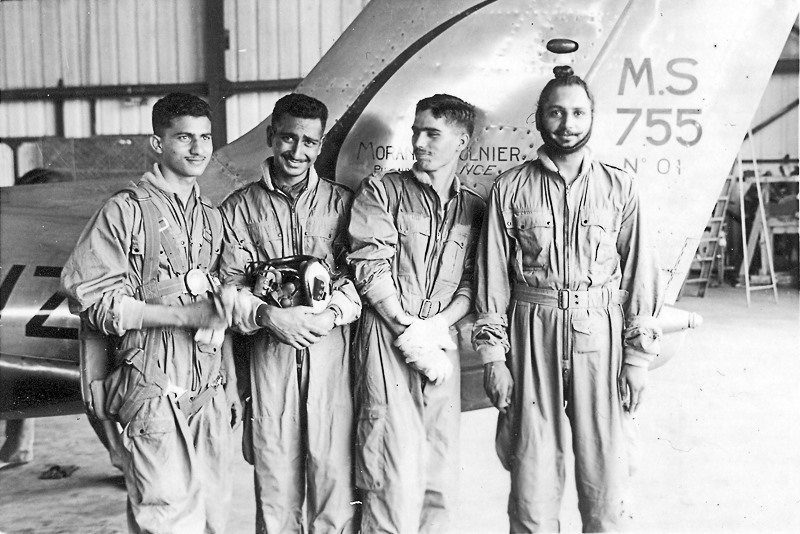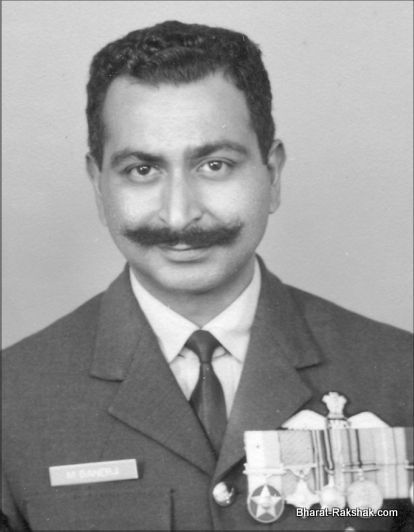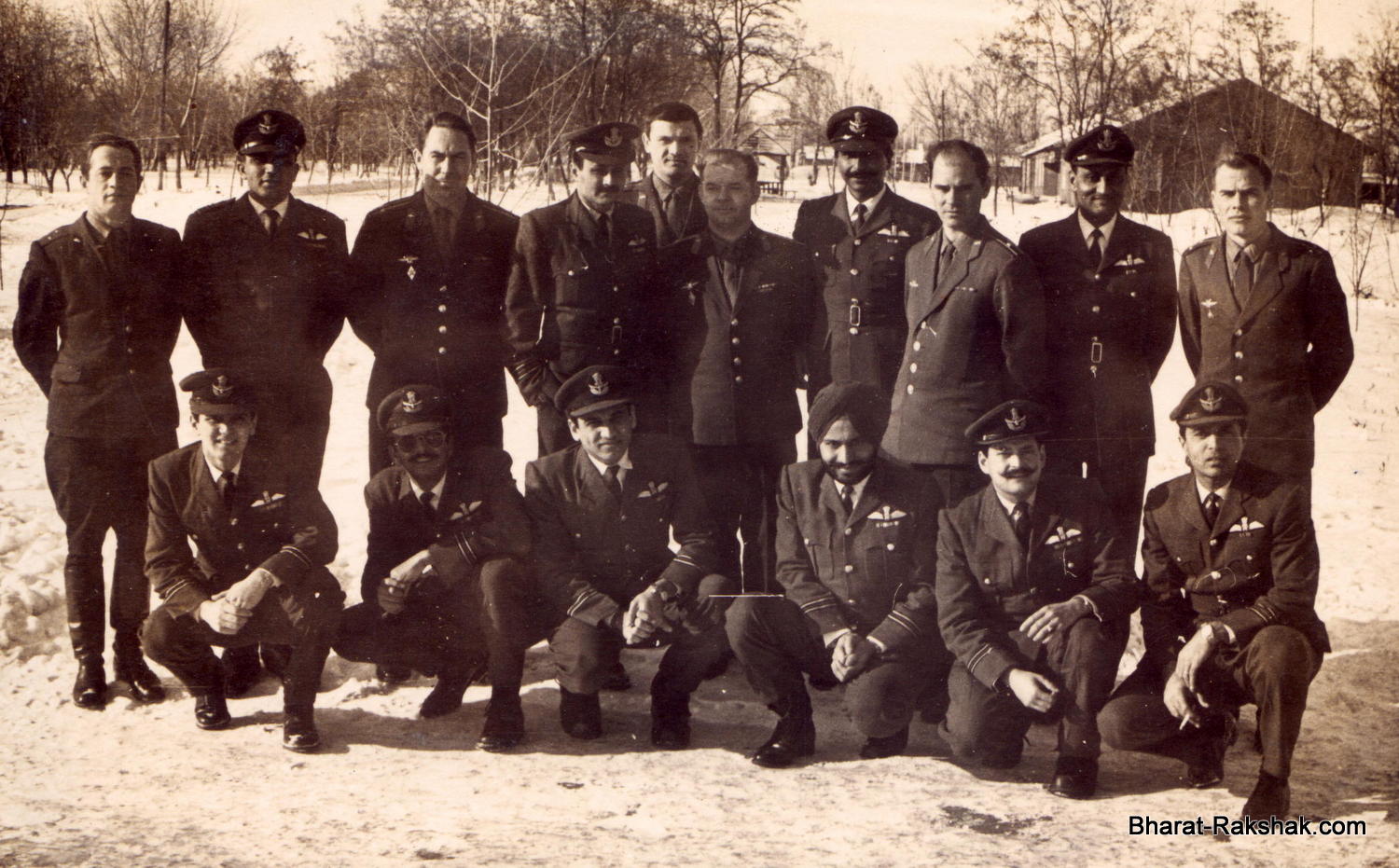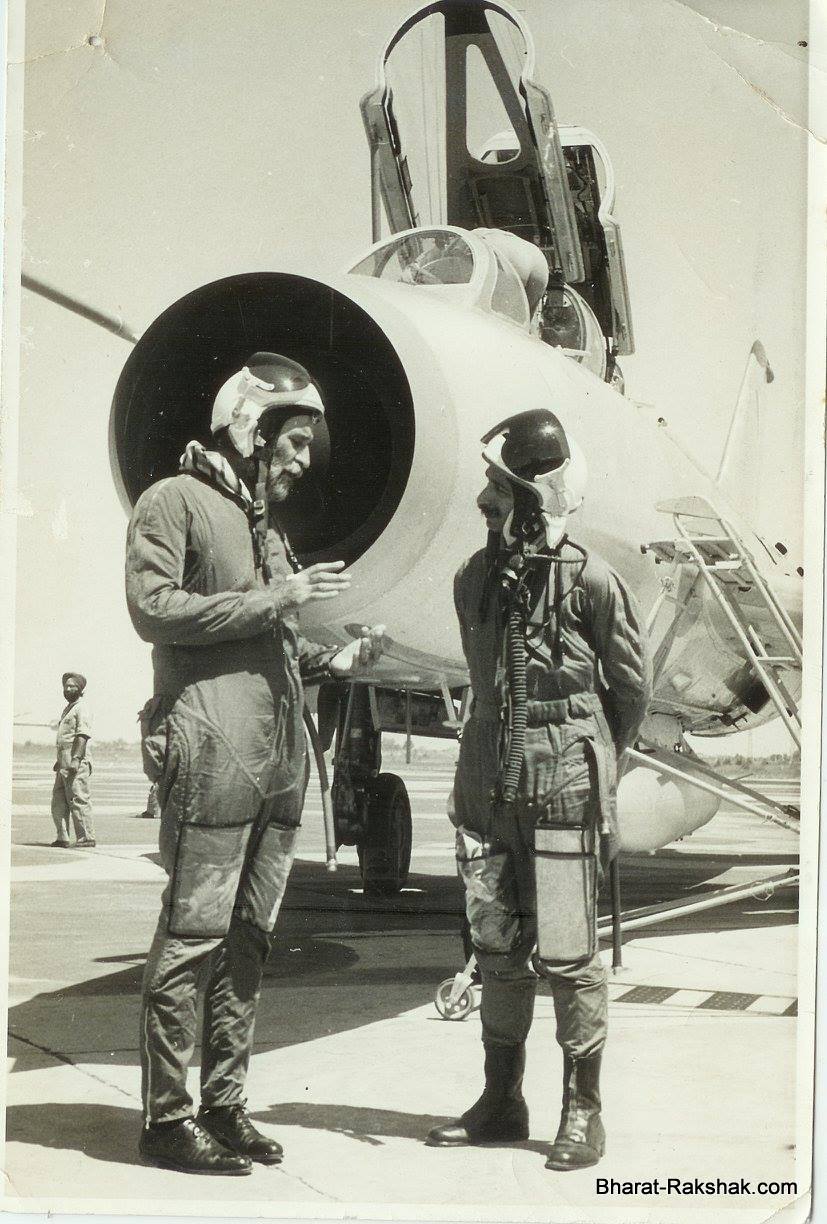An interview with late Air Vice Marshal Madhabendra Banerji (4898). On the 20th January 2019, Anchit Gupta met with AVM Banerji (Retired) and spend a few hours discussing his IAF days. It was to be the first of many such interactions, but sadly, AVM Banerji passed away later in 2019. AVM Banerji spoke about Su-7 induction into the IAF, the initial days of fighter night flying, the 1971 war for which he was given the MVC and his days as AOC, J&K. He was extremely forthcoming and reflective and minced no words.
An interview with Air Vice Marshal Madhabendra Banerji (4898). On the 20th January 2019, Anchit Gupta met with AVM Banerji (Retired) and spend a few hours discussing his IAF days. It was to be the first of many such interactions, but sadly, AVM Banerji passed away later in 2019. AVM Banerji spoke about Su-7 induction into the IAF, the initial days of fighter night flying, the 1971 war for which he was given the MVC and his days as AOC, J&K. He was extremely forthcoming and reflective and minced no words.
Madhabendra Banerji was born to Shri TR Banerji on 4 Jan 1934 in Calcutta. After completing his education, he joined the Indian Air Force in 1954, and was selected to train as a pilot with the 65 Course. During that time, he trained at Begumpet and later Jodhpur and was commissioned 16 Apr 1955. His initial part of his career was spent flying Vampire fighters, apart from Instructional Tenures. He was also an A1 QFI from FIS. By 1965, he was a Squadron leader and was appointed commanding officer of No.24 Squadron operating the Vampire aircraft. He took part in the Operations against Pakistan in the Eastern Sector.

Flt Cadet M Banerji, seen at Begumpet, undergoing training prior to commissioning in the IAF. He is seen with a MS Fleuret trainer, which was trialed by the IAF – he was one of the only six cadets to have flown on this type.
Induction of Sukhoi-7s and Introduction of tactical night fighter flying in the IAF (1969-70)
In 1966, the Indian Government evaluated the Soviet Sukhoi-7 BMK fighter bomber and eventually signed an agreement to induct them. The first Sukhois were received in March 1968 and six Squadrons would eventually form. Around the same time, the first batch of IAF pilots were sent for conversion training in the Soviet Union, Banerji being one of the chosen few. On his return he was posted to the first Sukhoi-7 Unit, No.26 Squadron, and was involved in the introduction of tactical night fighter flying in the IAF.
“We were in the first batch of the pilots to be trained on the Su-7 in Russia. After coming back, I had gone for a tactical course on the Sukhoi.
The first thing the Russians asked me was – “How much night flying have you done on the aircraft?”.
I replied – “none”.
They replied – “you are not using the aircraft to anywhere near its capability.”
They had very detailed data from NATO exercises done earlier that year – clearly showing the difference in damages and impact across Day and night, low, medium level and high level. The lesson learnt was that you must fly in the night if you wish to protect your forces.
Till that time, night flying in IAF was limited to a few sorties for the sake of it. As a regular part of the syllabus, with tactics was never carried out as part of a night force, especially low-level flying. The first lot of night flying was carried out when we were pilot officers (mid 1950s) and for our Flight commanders and Commanding officers it was not easy to adapt to something they had not done earlier in younger days. Many were terrified of the thought. But consequently, night flying never really was taken up seriously.
I enquired from the from course members if navigation would be a challenge? Afterall, the Su-7 had just an airspeed indicator and a compass which was way down in the display and required you to take your eyes away.
The response came “there is nothing as good as total darkness for navigation and I should experiment for myself”. If you were to ask any of the fighter pilots who grew up in the age when night flying is common, they will vouch for the ease of navigation on a dark night.
The first batch of Indian Pilots sent to train on the Sukhoi-7 at Lugvoya. Standing L to R: S.Lt Valeri, Flt Lt Hariharan, Lt Col Rasmaskin, Sqn Ldr A R Sridharan, S Lt Denibekov, Maj Kirlov, Sqn Ldr M Banerji, Maj Kuksa, Sqn Ldr D S Jafa, S.Lt Shimelov. Kneeling L to R: Flt Lt M McMahon, Flt Lt T S Dandass, Flt Lt Owen J D’Sena, Flt LT Bangash, Flt Lt S C Mamgain, Sqn Ldr K N Pillai. Photo Courtesy Gp Capt K HariharanAfter I came back, incidentally, there was a meeting at the Command to discuss operational syllabus and I was sent for it from the Squadron. I raised the aspect of introducing night flying and there was an uproar at the thought. I was taken to the SASO who questioned me on the subject and shot down my idea on the face of it. He called the Canberra fleet officers and asked them how they would feel if the Su-7 took up the role given to them. I do not blame them as they did their operational flying in a different era.
Sqn Ldr M Banerji with Air Chief Marshal Arjan Singh – right after he had given a flight to the Chief. This was in May 1968.
Thereafter, I went to Air Headquarters for a conference and did not raise the issue in the conference. However, most people knew of this simmering suggestion and discussed it unofficially. The Director of Operations (senior most officer in charge of flying ops at AHQ) had got wind of the discussion and raised the issue himself with me. He said, everyone is against you, but I have not forgotten about it and you will get the clearance in time.
In the coming months, the letter from Air Headquarters came clearing one squadron in each command to do the night flying syllabus. The Command gave the task to 26 Squadron, but the squadron did not have their heart in it and did not really utilize the opportunity to its potential, resulting in suboptimal results.
My CO in 101 sqn, KC Khanna, got the go ahead from WAC, and he gave the task to me. We started the task and had initial difficulties, but slowly we started to make it work. While we could not get the entire squadron operational but most of the senior pilots had got operational. Simultaneously, TACDE was formed and moved to Adampur and they were actively testing out night flying too. Sure enough, as soon as the war began, TACDE put in night flying to full use and they were the only force to reach Sargodha and were effective.
For his efforts with the Su-7 fleet, AVM Banerji was awarded the Vayu Sena Medal. His citation reads – “Squadron Leader Madhavendra Banerji has been a Flight Commander of an operational squadron since June 1968. He has flown a total of 3,826 hours and holds a Master Green instrument rating with an Instrument Rating Instructor endorsement. He was one of the first batch of pilots who had undergone flying training on a new type of supersonic aircraft. He displayed considerable initiative and professional skill and in a relatively short time trained the pilots of Squadron to full operational status. Throughout, Squadron Leader Madhavendra Banerji displayed professional skill, initiative and devotion to duty.”
1971 War
When the conflict with Pakistan arrived in 1974, Madhabendra Banerji was flight commander with 101 Squadron based at Adampur flying the Sukhoi-7s. The unit operated mostly in the Shakargarh Sector . As he would recall :
“When war happens, human behaviour alters, and different people behave and react differently to the circumstances. There were many a case of brilliant pilots not performing anywhere near the flourish they were known to have. Sometimes the other aspect is true too. People whom I considered in my own squadron weak and was at the point of separating them out, found out how wrong I could be when the war came about and how these men went about. I realised, with all my experience how little I knew of my own people. Especially two officers, both of whom are no more, having passed away after retiring from the IAF. I really thought they should not be sent on missions as unnecessary casualties could occur. But when the time came, they were there, they went up and did fantastically well. I personally learnt a lesson too (to never underestimate).
Low level flying and tactics
Another need of the war is to adapt to situation and modify tactics on the fly. As an example, one of the beliefs was that the lower you fly on the Su-7, the safer you are. Everyone was supposed to fly 100 meters or so above the obstruction level on the ground. But we all knew in war time, this would be a casualty and pilots would go lower. In the case of the Su-7, this could be a particularly dangerous situation, especially if you have dropped speed. All it takes at that height is for some arm fire to hit at the wrong place in the airframe. We were in the Chamb sector and we had this flying path where we could cut through a part of Pakistan and re-enter India allowing us more time to loiter around, but it left us open to enemy fire. We faced a lot of damage as a result
I was preoccupied with recce missions and planning the sorties, till Iqbal Ali came back from a sortie with a wound in his leg. The wound was due to small arms fire from the ground somehow managing to enter the cockpit. This gave us the realisations that the ground fire was getting us when we were crossing the border (four times in the process of going and returning). We discussed this and we decided to re-route and remain within our territory, taking a longer route. But this was not a problem as thought shorter, our time over target was still good enough to drop our bombs and return. Incidentally, the army had a problem with this, because they saw less of the aircraft in the air from where they were.
Of the four aircraft that I lost, two were just because of this – low speed – small arms fire and damage. So, we quickly decided to change tactics and moved to higher level for flying. Yes, we will see Ack-Ack, but it was not much of a problem. Ruski’s had learnt from the Vietnam war that one could fire from some distance and don’t need to come close. But how much of that we could apply, we had to learn on the go.
Squadron Losses
We also lost aircraft to Air to Air combat, where Wahi was brought down by a Mirage. Here also, as the flight commander, I feel I could have done better. For instance, jettisoning the drop tanks and how that affects the aircraft, none of us had done it. The pilot notes clearly state that when you jettison the drop tanks, nose will pitch up, but when you are flying at the speed of sound, how much is it and how is it, you can’t be sure. Unfortunately, at the time, he could have done this and got away but was shot down.
Another major change I wanted to make later, is that after Wahi’s loss our effectiveness had reduced. The PAF was giving us chase and our pilots were forced to drop bombs in a rush, spent less time on target and get out of the hot zone. So, I decided we should go as 4-aircraft ships, two to attack and two to cover at a higher altitude. This would take care of the chase, but it would mean the number of such missions we can take reduces. This time again, I was told Army will be unhappy with this and if I was wrong, “heads will roll”. I said sir – “heads will roll, one way or the other. Either I get shot down up there or I say my head will roll”. But we decided to go ahead, and this newer system worked out well. We straight away found the chasing by PAF fighters stopped. In addition, the command put two MiG-21s in the air which helped too. Making changes is essential in real time. One cannot have a doctrinal approach that everything must go just as per the book.
Other than TACDE, the only other pilot to get to Sargodha (but during day) on a recce mission was Chotu Mehta early in the campaign. He got back, though he flamed out as he touched down at Amritsar. He was being chased. We had anticipated this but were very confident we will not be shot down given the pattern we had worked out. This mission was to give comfort to the IAF that we can penetrate despite the air defence systems in place by PAF. (Author Note: Chotu Mehta was posted with 32 Sqn, also operating the Su-7 during the war)
A memorable attack on Gujrat Airfield
After 11th/12th December, our effort had reduced, and we had a stand down. After Chamb, there was nothing to do for the sqn. We were itching to do something or the other towards the war effort and looking for targets. During one of the missions, “Guru Shinde” (Retired Air Commodore AP Shinde, 5671) had done a recce on the Gujrat airfield (in Pakistan). The photo interpreter of this sortie told us that though our intel was that the airfield has no activity, the images showed the airfield had safety vehicles parked on the side and gave us a sense that it was being used off and on by aircraft.
Guru Shinde lead a 4-aircraft formation to attack the airfield. The last of the aircraft was told to take the recce camera shot as well. The photo he took has four bombs – one is bursting, the second one is just about touching the ground and started splitting, the third one is hanging in the air and the fourth one, his own, just left the aircraft. It is a classic photo that got taken and adorned the Air Headquarters for a long time right after the war as they put it up on the entrance. I am not aware where this photo languishes now.
Other Efforts
These random reconnaissance efforts were driven by personal initiatives and it was not that somewhere, someone was sitting, collating all the inputs coming from various sources and putting a coherent picture of it to form a target list, thinking ahead. That kind of thinking was lacking. The officer in the squadron had a very narrow view of the operations and is not bothered with what is happening elsewhere. One of the constraints was resources and we had got so accustomed to working with limited resources that some of the big long-term projects or ideas were never considered.
Inability to maximise the potential of the Su-7 in the 1971 war
We had, since the acquisition of the aircraft been requesting a certain type of armament (S-24 Rockets), but the acquisition process led to delays and it only landed with us, three days prior to the 1971 war. There was very little we could do to put it to use, except to conduct some live trials. Guru Shinde did test them out by dropping a few on huge fuel dumps outside Lahore.
Similarly, we had requested navigational aids, cryptography equipment that could help with pilot communication in the air secretly. All the equipment was eventually were given but too late to be of use for the 1971 war. There was insufficient time to practice and use these. This has been one of the biggest drawbacks I have seen in the IAF, we wait endlessly. I wonder what more the fleet could have achieved if these were in places in time.”

The late arrival of the S-24 rockets was also confirmed by Air Marshal Nana Menon, who was with the other Su-7 squadron. He had mentioned that around the 8th or 9th of December, 26 Sqn received the first batch of S-24 rockets from the USSR. The crates containing these rockets had instructions only in Russian. No English translations were sent or received from Air HQ/Command HQ. Some of the pilots and technicians who had been trained in the USSR translated the release conditions. Then Sqn Ldr TJ Fernandez and late JS Ghuman carried out the first mission armed with S-24s. The target- Sulaimanke Headworks. Though the operation was successful, the patient survived. No noticeable damage was done to dam. S-24s were fired in anger without any trials.Decades later, post the 1999 Kargil, the IAF did indeed setup a targeting cell at Air Headquarters and the job fell on none other than Wg. Cdr BS Dhanoa, later to be Air Chief of the IAF.
For his efforts in the 1971War, Sqn Ldr Banerji was awarded the MVC, one of the only two Sqn ldr rank officers of the war to be awarded. His citation reads – “Squadron Leader Banerji, a senior pilot in a fighter bomber squadron , led no fewer than 14 missions in S-22 aircraft within the first week of the present war against enemy targets, most of them in support of our Army in the Chhamb battles. During these missions, he destroyed two enemy tanks and two guns. On three occasions, he was personally responsible for attacking the enemy in the face of heavy ground fire, thus relieving pressure on our own troops. He has displayed bravery and skill in repeatedly returning to the fray in the face of extremely heavy ground fire.”
After his stint with 101 Sqn, he was posted as Commanding Officer of 9 Sqn, operating the Gnat at Hindon, his second squadron command. Thereafter he commanded FIS for two years and was AOC 16 Wing for another couple of years. Next few years were served in staff appointments at Training Command and AirHQ and in the NDC Course.
AOC Jammu and Kashmir
In early 1987 he was posted as the AOC of J and K where he was called upon to plan an audacious Strike mission
“Lt. Gen Handoo was the Northern Army commander and it was a great pleasure to be working with him as the Air officer in command of J&K. He was operational oriented and later as I reflect, he had nearly the exact idea, that General Musharaf later accomplished in the 1999 Kargil War in the opposite direction. One difference was the Lt. Gen Handoo had a use for Air Power as well in his plan. Having had a background of 101 sqn from the 1971 war and our ability to go deep into enemy territory, I was confident, we could attack uptill Gilgit/ Skardu , should the need arise and get back safely too.
After I took over, Lt. Gen Handoo met me and briefed me about his idea and asked for my opinion. His plan was to attack and occupy Gilgit and the entire northern ridge. A lot many people felt that if we could do this, eventually PoK could also fall subsequently. I was fully supportive and concurred with his plans and offered that since we now have the MiG-25 Foxbat, we can immediately start the Reconnaissance of the area. As I was given the discretion by the AOC-in-C WAC to use the Foxbat as needed, I went ahead and asked for some missions to be carried out. The Army took the mission outcomes and used it to it draw out its plans. The IAF was very much part of the plan across different dimensions.
In my view it was a brilliant plan but remained a plan as the political go ahead for it was not given. Lt. General Handoo left after a while but I continued with the reconnaissance missions. However, the proper analysis, records and strategy for the same was not carried forward further.”
Author Note: While AVM Banerji was most well known for his participation in the 1965 and 1971 war., much less known is that he was an outstanding instructor and spent considerable time in positions related to flying training. He commanded the flying instructor’s school, was the Command Flying Training officer at Training Command and finally retired as the Director of Training at Air Headquarters. It was my hope to have the next interview focus on purely flying training aspects in the IAF during his time, but fate had other ideas. In May 2019, AVM Banerji was diagnosed with Cancer, and he passed away in November. India has lost another air warrior
More on AVM Banerji’s career can be read here – http://www.bharat-rakshak.com/IAF/Database/4898

